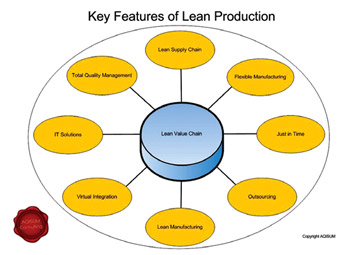Lean management
M.C. Mathupala
Businessmen and business enterprises have adopted many approaches in
their unceasing attempts to enhance their profits through higher levels
of productivity.
 They have based these attempts on the understanding that profit is
the difference between price and cost (profit = price - cost). They have based these attempts on the understanding that profit is
the difference between price and cost (profit = price - cost).
Increasing prices distracts customers from the goods and services
offered. Hence the better alternative is to reduce the cost of
production of the offered goods and services while maintaining their
quality. ‘Lean production’ evolved as the answer.
This article attempts to describe briefly, how the concepts of lean
production and lean management evolved and how they became two of the
recent popular strategies among the more successful entrepreneurs during
the last two or three decades.
The main emphasis here is on the reduction of waste that occurs in
tangible as well as intangible forms. Tangible waste is visible and
normally gets collected at the refuse or waste dump. But intangible
waste like excess movement of people and materials, idle time of
machines, unproductive time of executives and operatives, unutilized
space, etc., go unnoticed very often and get added to the final cost of
products and services.
Just like fat that can accumulate in our bodies and make us lethargic
and unfit, waste in an organization can lead to ‘organisational
sicknesses’. Hence the opposite of lean management is ‘fat management’.
Since the beginning of the last century many attempts were made by
pioneers like F.W. Taylor to find better, more productive and less
costly processes to produce goods and services for the diverse markets
that were emerging.
Work study, O&M, continuous production, task specialization,
incentive schemes, and a plethora of similar techniques were introduced
to workplaces as a result.
These led to higher levels of efficiency and helped the enterprises
adopting such techniques to capture markets and enhance their
profitability.
Consequent to the second world war and the quality movement in Japan
spearheaded by Professors Jurang and Deming the Japanese acquired the
expertise to produce ‘quality goods at reasonable prices’.
Many pioneers in disciplines like industrial engineering, production
management, product design and quality control emerged in Japan and
helped their industries to capture a large share of the global markets.
The approaches and techniques they initiated, developed, applied and
popularized in Japan spread right round the globe and are helping
entrepreneurs in all countries to enhance their productivity and profit
levels.
‘Just In Time (JIT)’ has helped them to get rid of, or reduce
inventories. ‘Kanban’ systems reduced the in-process inventories and
expedited production processes.
‘Zero defects’ assisted in achieving higher levels of quality and
eliminated rework and repairs while reducing inspection time.
Application of 5S made the workplaces more pleasant, better organized
and disciplined the total workforce. ‘Poka-yoka’ was instrumental in
error-proofing the production processes. All such approaches combined to
instill a sense of ‘Kaizen’ - continuous improvement- resulting in a
highly productive and progressive work ethic that is being emulated the
world over to make a ‘better tomorrow’.
Two leaders who emerged in Japan, Shigeo Shingo and Taiichi Ono,
contributed in many ways to help reduce waste.
Shigeo Shingo became world famous for SMED (single minute exchange of
die) and ‘poka yoka’ and Taiichi Ono is considered to be the expert
responsible for the Toyota Production System (TPS) that was developed in
2001 which helped Japanese businesses identify three major types of
waste: muda (non value adding work), muri (overburden), mura
(unevenness).
These developments that originated in Japan were adopted by
enterprises in other countries and led to the concept of ‘lean
management’ and spread to other management disciplines like finance
which has resulted in more purposeful and effective management
accounting and financial reporting systems.
The Toyota Production System focuses on (a) relentless elimination of
waste in the seven areas mentioned below; (b) kaizen or continuous
improvement and (c) respect for the workforce through the engagement of
long term relationships based on continuous improvement and mutual
trust.
The seven areas of waste - the seven ‘muda’ - identified are (1)
transport -moving materials and other articles unnecessarily; (2)
Inventory -keeping excess inventory prior to, during or after the
production processes; (3) Motion - people walking and/or moving
equipment more than what is required for efficient processes to produce
the targeted goods and services; (4) Waiting - waiting for the next
stage of production; (5) Overproduction; (6) Over processing and (7)
Defects.
Two more areas of waste have been added to the seven mentioned above
by recent thinkers. They are: (1) manufacturing products or providing
services that do not need customer demand or specifications and (2)
Waste of human talent. Wasted human talent is one of the intangible
wastes that go unnoticed in most workplaces. In addition to management
weaknesses in recruitment of talented employees and the appropriate
allocation of tasks and responsibilities, age old unproductive concepts
like ‘turf-consciousness’ among employees contribute to the generation
of such intangible wastes.
Lean management concentrates on the elimination of all such forms of
waste in order to achieve higher levels of productivity and
profitability. |



